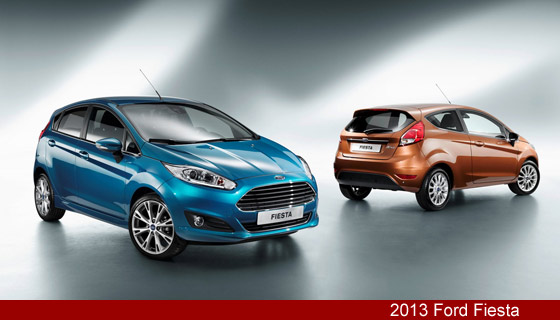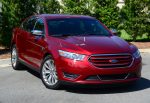The Ford Fiesta recently went through its midlife facelift with many subtle changes and some new engines. The overall effect of the new grille does make the car look a lot more upmarket – but the big news is the new Ecoboost engine that only has an almost unreal 1000cc engine size.
This new 1 liter Ecoboost models fits in above the existing 1.4 petrol and 1.6 TDCi diesel engines. Is Ford crazy, or is there some method in their madness with the new Ecoboost model?
The Looks
The Fiesta has always been a pretty good looking car with some almost French looking curves. This time round Ford has given the Fiesta a facelift, biggest of which is the new grille which reminds me of a small Aston Martin. The lights also look a bit more aggressive.
My test car came in a very bright “Candy Blue” car which does accentuate the new looks, but it does not do much for the “small dinky car” image which the Fiesta is trying to evade. The Ecoboost model comes in two trims – a lower end “Trend” model, and the more expensive “Titanium” model.
While the Trend does keep the Ecoboost engine, the small little 15 inch alloys don’t look great – it is perhaps the biggest reason I would opt for the Titanium spec model, which comes with 16 inch allow wheels. The Titanium model also comes with LED automatic headlights, which does give the car a bit more presence on the road.
The interior
The Fiesta is pretty great car inside. While the Trend model does not come with too many luxuries, the plastics inside the car feel a bit higher end than the price might suggest, but there is some hard plastic found lower down on the facia.
The cloth seats are firm yet very comfortable on long drives, and the driver seat was easy to get into a comfortable position. Seating in the rear is also more comfortable than the diminutive size of the car might suggest. The rear seats also includes iso-fix bars, so installing the baby car seat was a cinch.
Gadgets?
Considering the target market of the car, interior appointments in the form of connectivity and voice control is seemingly more important than things like the feel of plastics, right? The new Fiesta does not disappoint with its SYNC system which can be found across the range.
First off – voice control for in car sound systems is nothing new, but it has traditionally been fitted to cars that are far more expensive than the Fiesta. In most cases voice recognition is typically found as part of high-end optional navigation systems. The Fiesta comes standard with SYNC technology, which was developed in partnership with Microsoft. The system does not come with navigation, but you do get the idea that Ford is wizening up to the fact that most people these days use navigation software on their smartphones, and the system simply routes navigation commands through the speakers.
The big news with Sync is voice control. You can connect your phone via Bluetooth or USB – with Bluetooth you have the advantage of leaving your phone in your pocket, and music and phone calls get sent through the sound system. But you want to connect to USB if you want to see the real magic of SYNC. You simply press the voice command button on the steering wheel, and then the system can recognize more than 150 commands. There is also constant audio feedback, which can get a little irritating – but you can set it so that she is not too chatty.
I was super impressed by the voice recognition – it did not get a single song, artist or album wrong, and the phone dialing was equally amazing. It understood Afrikaans and Xhosa names without any issue, which I found incredible, especially if you have dealt with other voice control systems like Siri. I tested it with a iPhone 5, and had no issues.
That Engine
Ford’s new 1L Ecoboost engine is actually an amazing piece of technology. This tiny little engine has 92kw and 170Nm on tap, all from a engine block that can fit on a A4 sheet of paper.
Needless to say that power is reliant on some very interesting technology. A 3 cylinder engine normally has extra vibrations, but the flywheel has been intentionally unbalanced to counteract it and ensure smooth running. This is done without balance shafts which needlessly drain fuel economy.
A engine needs heat to ensure efficiency, and the Ecoboost uses a exhaust manifold which is cast into the cylinder head, which makes the engine heat up faster.
While 92kw might not sound like a lot, the little 3 cylinder engine is very quick to rev up, and it is an absolute hoot to drive. While the engine is made for fuel efficiency, I reckon most people will drive this engine pretty hard. When idle you can hear that it is a 3 cylinder engine, but once you hit around 4000 rpm it starts to make a lovely thrummy sound which I did not expect.
So is it actually fuel efficient? Yes. But not quite close to what you might get from the TDCi model. But if you want some fun with your sensibility, the Ecoboost make a very interesting proposition. While driving the car pretty hard for a week I averaged 6.6 litres per 100km. I reckon a calmer driver can easily reach below 6 liters per 100km.
The Drive
In typical Ford fashion, the Fiesta is a lot of fun to drive. The seating position combined with the way the gearshift feels means you want to drive the car a little harder than you should.
Suspension is reasonably soft, but with almost no body roll. Bumps and potholes are handled without too much drama, and there was very little that could lead to any drama in everyday driving. Part of the comfortable drive might be down to the Trend’s thicker tyres/small wheels combo. The Titanium might have harder driving characteristics. Dirt roads handled well as well.
The Ecoboost model has start/stop functionality, but is very choosey about when it uses it – it will not switch off if the air conditioner is running, or if the engine is not running at the right temperature yet. In use it works very well, and actually very seemless in everyday use. The Ecoboost also comes with hill ascent control, which I did not expect in a car this small. But it works well in Cape Town’s hilly stop streets.
The Fiesta does lack some of the fancier driving dynamics features like torque vectoring, and the Trend model also lack ESP which will make some over-enthusiastic drivers a little more confident. One again I think the Titanium model might be worth the additional outlay.
Then again, if it is driving dynamics your after, you should not even bother with this model. The Fiesta ST is out there, and we are reviewing it soon as well…
Overall
 The Fiesta Ecoboost is a great little car – while the Ecoboost engine might look like the sensible buy, it is indeed a lot of fun to drive. While other brands are opting for efficient engines which are aimed only at eventual fuel usage, the Ecoboost is a more sporty drive.
The Fiesta Ecoboost is a great little car – while the Ecoboost engine might look like the sensible buy, it is indeed a lot of fun to drive. While other brands are opting for efficient engines which are aimed only at eventual fuel usage, the Ecoboost is a more sporty drive.
The Fiesta Ecoboost is in my opinion the best small hatchback in South Africa. Traditionalists might stick with their VW Polos, but from a engineering and technologist standpoint, nothing comes close to it.
In terms of small power plants which give great fuel economy the Fiesta’s biggest competitor might come in the somewhat odd form of the Polo Bluemotion. While it is way down on power, it also uses a tiny 3 cylinder power plant (albeit with diesel).
At R213 000 the Fiesta Ecoboost does come in a little dearer than the VW Polo Bluemotion, but you do get a car that is a lot more fun to drive.






